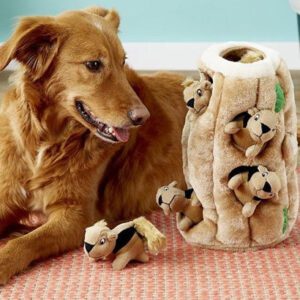 |
Key Points on the Benefits of Structured Playtime for Dogs:
|
| Structured playtime provides dogs with more than physical exercise; it engages their minds through goal-oriented activities that encourage problem-solving and cognitive growth. By incorporating commands and structured games, playtime becomes an opportunity to reinforce training, build obedience, and improve overall behavior, making it easier for dogs to respond positively in various situations. Through structured play, dogs and owners experience a more fulfilling relationship, creating a foundation of mutual respect and enjoyment. | |
The Key Benefits of Structured Playtime
1. Promotes Physical Fitness
Structured playtime provides controlled physical activity. Games such as agility training, fetch with commands, or obstacle courses build endurance, support joint health, and help maintain a healthy weight. These activities can be tailored to individual dogs, focusing on specific needs, such as agility for high-energy breeds or low-impact play for seniors.
For example, high-energy breeds like Border Collies benefit from extended periods of active play. In contrast, low-energy breeds such as Bulldogs may need shorter sessions with less intensity to prevent overexertion. Integrating structured play sessions keeps dogs active and helps reduce the risk of obesity and associated health problems.
2. Enhances Mental Stimulation
Structured play that involves cognitive challenges, like puzzle toys or games of hide-and-seek, encourages dogs to think through problems and helps ward off boredom—which can sometimes lead to destructive habits. These mentally stimulating games allow dogs to tap into their natural instincts in a positive way.
Providing mental enrichment is particularly important for working breeds, such as German Shepherds, which have a high need for both physical and mental challenges. Structured activities that engage their minds can lead to calmer behavior and lower anxiety, creating a more balanced pet.
3. Reinforces Training and Obedience
Structured play is a great time to reinforce basic commands like “sit,” “stay,” “fetch,” and “drop.” Using games that require obedience improves behavior, making daily interactions easier and safer. Playful training also enhances impulse control, as dogs learn to wait for cues before acting, which can be helpful in various real-life situations.
For example, by incorporating commands during a game of fetch, you’re teaching your dog to listen and respond to instructions, even during exciting moments. Structured play integrates training seamlessly, helping dogs learn good behavior in a fun way.
4. Strengthens the Human-Dog Bond
Engaging in interactive games with structured rules fosters trust and strengthens the bond between dogs and their owners. During structured play, dogs look to their humans for guidance, building a sense of teamwork and enhancing attachment.
Structured play is particularly beneficial for rescue dogs or dogs with anxiety, as it helps them build confidence and trust. When dogs understand that playtime is safe and guided, they respond more to their owner’s cues.
Table 1: Comparison of Structured vs. Free Play for Dogs
| Aspect | Structured Play | Free Play |
| Mental Stimulation | High (requires focus and obedience) | Moderate (varies by activity) |
| Physical Activity | Moderate to High | High |
| Bonding | Strong bonding through cooperation | Moderate |
| Skill Development | Enhanced through guided activities | Limited |
| Behavioral Control | Promotes impulse control | Limited |
Types of Structured Play for Dogs
1. Fetch with a Twist
Traditional fetch becomes a structured game by adding commands like “wait,” “leave it,” or “bring it.” You can increase the complexity by using multiple toys and asking your dog to retrieve a specific item. This version of fetch enhances obedience and problem-solving skills.
2. Hide-and-Seek
Hide treats or toys around the house or yard and encourage your dog to find them. This activity engages their natural hunting instincts and uses scent and problem-solving skills. It’s particularly effective for dogs with strong prey drives, like Terriers or Hounds.
3. Obstacle Courses
Create a simple obstacle course using household items or equipment like tunnels, hoops, and cones. Encourage your dog to navigate through it, reinforcing commands like “up,” “over,” and “through.” Obstacle courses build confidence, agility, and obedience in a fun, engaging way.
Table 2: Examples of Structured Play Activities and Their Benefits
| Activity | Primary Benefit | Commands to Use |
| Fetch with Commands | Physical Fitness, Impulse Control | “Fetch,” “Drop,” “Stay” |
| Hide-and-Seek | Mental Stimulation | “Find it,” “Go,” “Come” |
| Tug-of-War | Bonding, Behavioral Control | “Tug,” “Let go,” “Stop” |
| Agility Course | Confidence, Physical Fitness | “Up,” “Through,” “Around” |
| Nose Work | Problem Solving, Natural Instincts | “Search,” “Where is it?” |
How to Implement Structured Play in Daily Life
1. Set Clear Goals
Each play session should have a clear purpose, whether it’s to reinforce obedience commands or give your dog a mental workout. Having a specific focus keeps sessions consistent and makes structured play an effective tool for training and behavior improvement.
2. Establish Rules and Boundaries
Structured play should include simple rules that your dog can easily understand. For instance, during tug-of-war, set a rule that the dog must release the toy on command. This teaches impulse control and respect for boundaries, enhancing the safety and enjoyment of playtime.
3. Use Positive Reinforcement
Reward your dog during structured play with treats or praise. Positive reinforcement makes playtime more enjoyable and increases your dog’s enthusiasm for engaging in future activities, reinforcing desired behaviors.
4. Adapt Activities to Your Dog’s Age and Abilities
Young dogs may benefit from high-energy activities like obstacle courses, while seniors might enjoy slower-paced games like scent work. Adjusting play to your dog’s abilities ensures a safe and enjoyable experience.
Table 3: Recommended Playtime for Dogs by Age and Energy Level
| Age Group | Energy Level | Suggested Daily Playtime | Activity Examples |
| Puppies (up to 1 year) | High | 3-4 sessions, 15-30 mins each | Fetch, gentle tug-of-war, short walks |
| Young Adults (1-3 years) | High | 2-3 hours | Agility games, longer walks, interactive puzzles |
| Moderate | 1-1.5 hours | Fetch, short hikes, structured play at home | |
| Adult Dogs (4-7 years) | High | 1.5-2 hours | Running, obstacle courses, scent games |
| Moderate | 1-1.5 hours | Structured play with toys, neighborhood walks | |
| Low | 30-60 minutes | Gentle play with breaks, low-impact activities | |
| Senior Dogs (8+ years) | Moderate | 30-60 minutes | Gentle fetch, nose work, slow walks |
| Low | 20-30 minutes | Interactive toys, light play at a slow pace |
Toys for Structured Playtime
| Toy Type | Description | Primary Benefits | Suggested Activities |
| Interactive Puzzle Toys | Toys with hidden compartments for treats or kibble | Mental stimulation, problem-solving skills | Use for hide-and-seek or as a reward puzzle |
| Fetch Balls | Durable balls, some with squeakers or lights | Physical fitness, impulse control | Fetch games with commands like “fetch” and “drop” |
| Tug Toys | Sturdy ropes or rubber toys for tugging games | Bonding, behavioral control | Tug-of-war with “tug” and “let go” commands |
| Agility Tunnels | Lightweight, collapsible tunnels | Confidence, agility | Use as part of an obstacle course to build skills |
| Scent Work Toys | Toys designed for scent training, often with compartments for treats | Problem-solving, natural instincts | Nose work games with commands like “find it” |
Quick Tips: Playtime Do’s and Don’ts
Do’s
- Do use positive reinforcement: Praise and reward your dog during play.
- Do provide a variety of toys: Rotate toys to keep playtime fresh.
- Do set boundaries: Teach commands like “stop,” “leave it,” and “drop.”
- Do monitor play intensity: Ensure activities suit your dog’s age and energy.
- Do incorporate training: Use play to reinforce basic commands.
Don’ts
- Don’t encourage aggressive play: Avoid rough games that could lead to unwanted behaviors.
- Don’t overdo it: Watch for signs of fatigue and give breaks.
- Don’t use inappropriate toys: Avoid toys that pose a choking risk.
- Don’t ignore social cues: Switch activities if your dog shows disinterest.
- Don’t skip warm-ups for high-energy play: Prevent muscle strain by easing in.
Must-Have Toys for Engaging and Structured Dog Play
Benefits for Dog Owners
Structured play provides numerous benefits for owners. Participating in structured play brings a sense of fulfillment, knowing you’re contributing to your dog’s mental and physical well-being. Structured play offers dogs and their owners a meaningful way to bond, train, and support overall health. Through purposeful play, owners can make daily life easier with a well-behaved, relaxed dog while finding stress relief and joy in watching their dogs learn and grow.
Conclusion
Structured play also allows owners to develop training skills, making it easier to manage other behaviors over time. As a final thought, incorporating structured play into your dog’s routine creates a happy, healthy pet and enhances your relationship with them, making it more rewarding for both.











